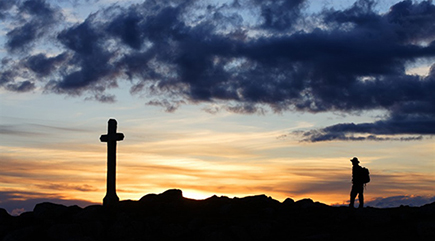
'Footprints' follows pilgrims on the nearly 600-mile hike through France, Spain
Eleven young men set out on an epic journey, each in search of God’s voice. Spanish filmmaker Juan Manuel Cotelo walked beside them for the nearly 600-mile hike that began on the border between France and Spain during the summer of 2014. “Footprints,” the fruit of the experience, is a compelling documentary about the quest and the inspiring transformation the men experienced.
It began the way most things do, as a dream.
Father Sergio Fita, a native of Spain and the pastor of St. Anne Parish in Gilbert, Arizona, had long dreamed of walking the Way of St. James, the historic pilgrimage that culminates in Santiago de Compostela, Spain, where the remains of the apostle James were discovered centuries ago. Each year, thousands of pilgrims walk the grueling Camino de Santiago popularized in “The Way,” a 2010 film starring Martin Sheen.
Cotelo, who has been crafting films for 25 years, was approached by Father Fita and agreed to make the documentary.
In an interview with Our Sunday Visitor, Cotelo recalled then-Cardinal Jorge Bergoglio inquiring about “The Last Summit,” his film about a priest. “How can we get this movie to Argentina?” the future pope asked him.
With breathtaking shots, gorgeous cinematography, and heartfelt, inspiring dialogue, “Footprints” is likely to receive similar reception by Church leaders. Cotelo and Father Fita were invited by the Pontifical Council for Promoting the New Evangelization to bring the film to the Vatican on July 29. That’s after they’ve shown it to the bishops of Spain, many of whom will be in Santiago de Compostela on July 24, the eve of the feast of St. James, the nation’s patron saint.
The opening scene of “Footprints” introduces the eclectic group of pilgrims with a brief vignette on each, including Troy, 23, who played college football and is a Zumba instructor. Patrick, 31, is an artist, while John, 28, once battled drug and alcohol addictions. Viewers also get to know Kevin, 21, a seminarian, and Ivan, 20, who is rediscovering his faith while grieving the death of several loved ones.
As the journey commences, the pilgrims are all smiles, with a spring in their step, eager to see the path unfold before them. Father Fita places a necklace with the iconic conch shell that symbolizes the Camino around each man’s neck. The film then cuts to an on-the-scene interview Cotelo conducted with the local bishop, who offers his shrewd appraisal of the group.
Soon enough, they’ll find out, the bishop says, and the smugness and naiveté will vanish. “The first time they encounter suffering, it’s traumatic.”
Though picturesque, the northern route that Father Fita has chosen for the men to walk features rocky paths, steep inclines and perilous cliffs, all traversed with heavy backpacks, at times through rain and mist.
The camera focuses on pilgrims early in the venture, gingerly examining their blister-covered feet. Already some feel discouraged and wonder if they should quit. One comes down with a stomach bug. Another battles asthma in the humid environs. All the while, they finger their rosary beads, contemplate the beauty around them and trudge forward, step by step.
Troy, the former college football player, arguably in peak physical condition, captures the mood succinctly: “Nothing can prepare you for this.”
Another pilgrim offers his blunt assessment: “I imagined it was going to be tough, but not as tough as the first few days.”
Each day, Father Fita celebrates Mass for the pilgrims. There’s an incredible shot of him silhouetted against a majestic background as he elevates the Eucharist.
“Suffering is important to a pilgrimage,” Father Fita tells them. “Difficult moments must not overcome us. We must overcome them.”
Throughout the film, viewers are given the mileage count. At one point, the pilgrims still have nearly 300 miles to go, and it’s starting to look rather impossible. They’re not really walking as a group anymore but have broken into small clusters. Lessons are beginning to sink in, and one pilgrim offers his take. “Whatever life throws at you, you have to keep walking.”
They leave the trail behind one day and visit a church where they venerate a relic of the Cross of Christ. “We’re exploding with joy,” one pilgrim says. “At moments like this, it all seems worth it.”
After venerating the cross, there’s a distinct change among the pilgrims. They have to make a decision: Should they continue to walk separately or as a united group? They decide they will journey together, rotating a leader every seven minutes.
“With that principle, our way of walking changes completely,” one man says. Another agrees. “We’re brothers now. We’re stronger together than as individuals.” Cotelo captures scenes of them pushing each other up hills, persevering through pain, and deciding that they will walk the final miles barefoot, exultant to glimpse Santiago de Compostela at last.
In the end, viewers know that each man heard the voice of God during the Camino and returns home ready to begin his life anew, invigorated and inspired by the difficult journey and the brotherhood developed through suffering and joy. “Footprints” isn’t just a tribute to a hike; it’s an invitation, beautifully rendered, to seek the voice of God wherever one may be.